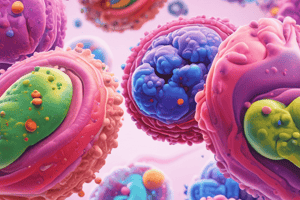Podcast
Questions and Answers
¿Cuál es el único método que previene las ETS de manera efectiva?
¿Cuál es el único método que previene las ETS de manera efectiva?
- Métodos de barrera como los condones (correct)
- Pastillas anticonceptivas
- Diapositivos intrauterinos
- Métodos naturales
¿Qué opción describe mejor el diagnóstico del cáncer de útero?
¿Qué opción describe mejor el diagnóstico del cáncer de útero?
- Ultrasonido
- Examen de sangre
- Radiografía
- Papanicolaou (correct)
¿Qué bacteriana enfermedad puede extenderse al cerebro si no se trata?
¿Qué bacteriana enfermedad puede extenderse al cerebro si no se trata?
- Clamidia
- Sífilis (correct)
- Gonorrea
- Candisiasis
¿Qué ITS es causante de verrugas genitales?
¿Qué ITS es causante de verrugas genitales?
¿Cuál es un método recomendado para reducir las muertes por cáncer cervicouterino?
¿Cuál es un método recomendado para reducir las muertes por cáncer cervicouterino?
¿Qué afirmación es falsa respecto a las ITS?
¿Qué afirmación es falsa respecto a las ITS?
¿Cuál de las siguientes ITS se considera la más común en Chile?
¿Cuál de las siguientes ITS se considera la más común en Chile?
¿Qué afirmación respecto a los métodos anticonceptivos hormonales es cierta?
¿Qué afirmación respecto a los métodos anticonceptivos hormonales es cierta?
¿Cuál de las siguientes afirmaciones sobre el VIH es verdadera?
¿Cuál de las siguientes afirmaciones sobre el VIH es verdadera?
¿Qué significa la sigla VIH?
¿Qué significa la sigla VIH?
¿Cuál es la etapa más avanzada de la infección por VIH?
¿Cuál es la etapa más avanzada de la infección por VIH?
¿Cuáles de los siguientes métodos son efectivos para prevenir la transmisión de ITS?
¿Cuáles de los siguientes métodos son efectivos para prevenir la transmisión de ITS?
¿Qué afirmación sobre los síntomas del VIH es correcta?
¿Qué afirmación sobre los síntomas del VIH es correcta?
¿Cuál es el tratamiento estándar para el VIH?
¿Cuál es el tratamiento estándar para el VIH?
¿Cuál de las siguientes afirmaciones es falsa sobre las ITS?
¿Cuál de las siguientes afirmaciones es falsa sobre las ITS?
¿Cuál de las siguientes afirmaciones sobre la estabilidad de la salud de un portador de VIH sin tratamiento es correcta?
¿Cuál de las siguientes afirmaciones sobre la estabilidad de la salud de un portador de VIH sin tratamiento es correcta?
¿Qué caracteriza a una infección de transmisión sexual (ITS)?
¿Qué caracteriza a una infección de transmisión sexual (ITS)?
¿Cuál de las siguientes opciones es un factor de riesgo para las ITS?
¿Cuál de las siguientes opciones es un factor de riesgo para las ITS?
¿Qué se entiende por embarazo adolescente?
¿Qué se entiende por embarazo adolescente?
¿Cuál es una de las formas de prevención de las ITS?
¿Cuál es una de las formas de prevención de las ITS?
¿Qué impacto puede tener la pobreza en el embarazo adolescente?
¿Qué impacto puede tener la pobreza en el embarazo adolescente?
¿Cómo pueden las ITS ser transmitidas de madre a hijo?
¿Cómo pueden las ITS ser transmitidas de madre a hijo?
¿Cuál de las siguientes afirmaciones sobre la educación sexual es correcta?
¿Cuál de las siguientes afirmaciones sobre la educación sexual es correcta?
¿Qué práctica puede aumentar el riesgo de contraer una ITS?
¿Qué práctica puede aumentar el riesgo de contraer una ITS?
¿Cuál de las siguientes afirmaciones sobre la gonorrea es correcta?
¿Cuál de las siguientes afirmaciones sobre la gonorrea es correcta?
¿Qué caracteriza al herpes genital?
¿Qué caracteriza al herpes genital?
¿Cuál es la función principal del VIH en el organismo?
¿Cuál es la función principal del VIH en el organismo?
¿Cómo se trata la candidiasis?
¿Cómo se trata la candidiasis?
¿Cuál de estas afirmaciones sobre el VIH es cierta?
¿Cuál de estas afirmaciones sobre el VIH es cierta?
¿Qué tipo de infecciones puede causar la depresión inmune provocada por el VIH?
¿Qué tipo de infecciones puede causar la depresión inmune provocada por el VIH?
¿Cuál de las siguientes complicaciones puede surgir de una infección por gonorrea?
¿Cuál de las siguientes complicaciones puede surgir de una infección por gonorrea?
¿Cuál es el tratamiento recomendado para una infección de herpes genital?
¿Cuál es el tratamiento recomendado para una infección de herpes genital?
Flashcards
HIV Transmission
HIV Transmission
HIV is primarily transmitted through sexual contact, not just sexual contact.
HIV and Immune System
HIV and Immune System
HIV weakens the immune system by destroying T-lymphocytes, which are critical for fighting infections.
HIV Symptoms
HIV Symptoms
Often, HIV infection initially shows no symptoms.
HIV Progression (Untreated)
HIV Progression (Untreated)
Signup and view all the flashcards
AIDS Definition
AIDS Definition
Signup and view all the flashcards
HIV Treatment
HIV Treatment
Signup and view all the flashcards
STI Prevention Methods
STI Prevention Methods
Signup and view all the flashcards
STI Detection Difficulty
STI Detection Difficulty
Signup and view all the flashcards
Sexually Transmitted Infections (STIs)
Sexually Transmitted Infections (STIs)
Signup and view all the flashcards
Teenage Pregnancy
Teenage Pregnancy
Signup and view all the flashcards
STI Risk Factors
STI Risk Factors
Signup and view all the flashcards
Teenage Pregnancy Risk Factors
Teenage Pregnancy Risk Factors
Signup and view all the flashcards
STI Prevention
STI Prevention
Signup and view all the flashcards
STI Transmission
STI Transmission
Signup and view all the flashcards
STI Pathogens
STI Pathogens
Signup and view all the flashcards
STI Risk Groups
STI Risk Groups
Signup and view all the flashcards
STIs in Chile
STIs in Chile
Signup and view all the flashcards
STI Prevention
STI Prevention
Signup and view all the flashcards
HPV (Virus del papiloma humano)
HPV (Virus del papiloma humano)
Signup and view all the flashcards
Pap Smear
Pap Smear
Signup and view all the flashcards
Syphilis
Syphilis
Signup and view all the flashcards
Cervical Cancer in Chile
Cervical Cancer in Chile
Signup and view all the flashcards
Chlamydia
Chlamydia
Signup and view all the flashcards
ITS & Pregnancy
ITS & Pregnancy
Signup and view all the flashcards
Candida albicans
Candida albicans
Signup and view all the flashcards
Herpes simplex
Herpes simplex
Signup and view all the flashcards
Gonorrhea
Gonorrhea
Signup and view all the flashcards
HIV
HIV
Signup and view all the flashcards
AIDS
AIDS
Signup and view all the flashcards
HIV Transmission
HIV Transmission
Signup and view all the flashcards
HIV Action
HIV Action
Signup and view all the flashcards
HIV Symptoms
HIV Symptoms
Signup and view all the flashcards
Study Notes
Clase 6: Infecciones de transmisión sexual (ITS)
- El objetivo de la clase es describir las ITS más comunes en Chile y las medidas generales de prevención.
Resumen de la clase anterior
- Se plantean preguntas sobre la importancia del control de la natalidad y la paternidad responsable.
Conceptos previos
- Embarazo adolescente: Embarazo en mujeres menores de 20 años.
- Infecciones de transmisión sexual (ITS): Enfermedades que se contagian de una persona a otra a través del contacto sexual.
Factores de riesgo de embarazo adolescente
- Sociales: Influencia de la falta de educación sexual.
- Económicos: Impacto de la pobreza: falta de acceso a servicios de salud.
- Culturales: Normas culturales en el embarazo adolescente: aceptación, acceso restringido a anticonceptivos, tabú.
Factores de riesgo de ITS
- Desinformación: Falta de conocimiento sobre ITS
- Falta de uso de protección: Falta de uso de condones.
- Prácticas sexuales riesgosas: Actividades sexuales sin protección.
ITS más comunes en Chile
- Condiloma- VPH
- Sífilis
- Gonorrea
- Herpes
- Clamidia
- Candidiasis
Virus del papiloma humano (VPH)
- Causa verrugas genitales y cáncer cerviuterino.
- Se recomienda el Papanicolaou a partir de los 21 años.
Sífilis
- Causada por una bacteria que puede afectar otros órganos si no se trata.
- Se trata con antibióticos.
Clamidia
- Infección bacteriana, generalmente asintomática.
- Puede causar inflamaciones genitales, conjuntivitis e infertilidad.
- Se trata con antibióticos.
Candidiasis
- Causada por un hongo.
- Afecta la zona genital y otros lugares de la piel y mucosas.
- Se trata con antimicóticos.
Herpes genital
- Causada por un virus que produce ampollas dolorosas que pueden aparecer en distintas zonas del cuerpo.
- No tiene cura, pero se puede controlar con antivirales.
Gonorrea
- Causada por una bacteria.
- Transmitida por vía sexual y de madre a hijo.
- Provoca inflamación del tracto urogenital.
- Se trata con antibióticos.
VIH/SIDA
- El VIH es el virus de inmunodeficiencia humana.
- El SIDA es el síndrome de inmunodeficiencia adquirida.
- El VIH ataca a los linfocitos T, deteriorando el sistema inmunológico.
- El VIH puede presentarse sin síntomas durante un tiempo.
- Se trata con antirretrovirales.
Prevención de ITS
- Utilizar preservativos durante las relaciones sexuales.
- Tener una pareja sexual única.
- Practicar la abstinencia sexual.
Magnitud del problema de las ITS
- Datos de la OMS al 2016: Se estima que, anualmente, alrededor de 357 millones de personas contraen alguna ITS; 36 millones están en América Latina. Mas de 290 millones de mujeres están infectadas con el virus del papiloma humano (VPH), al 2016.
Medidas de Prevención
- El uso de métodos de barrera es fundamental para prevenir el contagio de ITS
- Las ITS no se previenen con anticonceptivos hormonales o naturales por que no impiden el contacto directo con los órganos.
Otros temas
- Información sobre la incidencia del VIH en Chile.
- Cifras sobre la tasa de infección por gonorrea según sexo y edad.
- Datos sobre la tasa de casos y tasas de infección por VIH /SIDA según grupos de edad y sexo, en diferentes años.
Studying That Suits You
Use AI to generate personalized quizzes and flashcards to suit your learning preferences.




